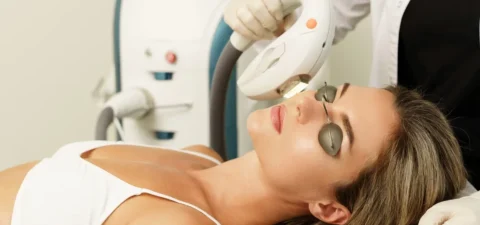For information only. Not meant as advice in any form. Please consult your medical professional or lawyer.
Patients who are struggling with their skin conditions often turn to estheticians or aestheticians. To those who aren’t familiar with the skincare industry, these two professions seem very similar which is why they’re usually used interchangeably. However, there are significant differences between them and it’s more than just their spelling.
So how exactly can you distinguish an aesthetician from an esthetician? Aestheticians are licensed skincare professionals who are trained in providing treatments in a clinical or medical setting. They usually work alongside a dermatologist or plastic surgeon in administering advanced cosmetic procedures. Meanwhile, estheticians are specialists who are employed in salons and day spas and provide standard facials, beauty services, and body treatments.
What Is The Difference Between An Esthetician and Aesthetician?
A lot of individuals are often confused with the terms aesthetician and esthetician. At a quick glance, it might seem that their only difference is with their spelling where you add or remove the ‘a’ at the beginning of the word. It’s thought that esthetic is the more commonly used spelling variant in the US, while aesthetic is usually used in British English.
These two words also technically refer to the same thing which is the study and appreciation of beauty and art. In the skincare industry, aesthetics and esthetics encompass a wide range of cosmetic services and treatments that are used to improve one’s appearance.
However, there are several differences in the scope of responsibilities, services, training requirements, and employment setting of aestheticians and estheticians. If you’re interested in starting a career in skincare, you should know the distinctions between the two job positions to manage your expectations and decide which profession is for you. Here’s an overview of the comparison between a standard esthetician and a medical aesthetician:
1) Common Responsibilities and Services Provided
Aestheticians are licensed professionals who can provide medical-level skin treatments and non-invasive cosmetic procedures. They are also known as medical aestheticians or paramedical aestheticians in any clinical setting. Some of their typical responsibilities can include:
- Analyze and diagnose a patient’s skin problem
- Recommend ideal skin care products that can help enhance their appearance and maintain skin health
- Provide expert skin advice on how to minimize the effects of aging
- Perform advanced therapies for skin rejuvenation, acne treatment, and scar removal
- Administer lymphatic massage to help patients recover from surgery
- Provide laser treatment for hair removal and tattoo removal
- Provide advanced chemical peels for skin exfoliation and resurfacing
On the other hand, an esthetician is a skincare specialist who can offer basic facial and cosmetic services designed to treat minor and superficial skin issues. Their job description typically looks like:
- Suggest appropriate skin care treatment after an initial consultation
- Provide chemical peels, facial masks, and microdermabrasion treatments for skin cleansing and exfoliation
- Perform laser hair removal and other methods for hair care and elimination such as waxing and tweezing
- Administer facial or body massages
- Provide aromatherapy to enhance a patient’s skin health and overall wellness
- Offer spray tanning services
- Makeup application, eyelash extensions, and eyebrow shaping
- Assist physicians by preparing patients for the procedure and sanitizing treatment rooms and equipment
2) Training and Education Requirements
Both aestheticians and estheticians are required to obtain a degree from an accredited cosmetology program or esthetician school. They’re also mandated to undergo at least 260 to 600 hours of hands-on training and practice before being able to work in a salon or medical setting.
The only difference is that most medical aesthetic programs taken by aestheticians focus more on clinical concepts, while standard esthetician courses are generalized about cosmetology practices, facial treatments, hair removal, and makeup applications. Estheticians also learn about proper sanitation techniques, disinfection, and basic salon management.
Medical aestheticians are more knowledgeable in advanced anatomy and physiology of the human skin and body. They also receive training on the latest techniques in anti-aging therapy and medical treatment for skin disorders.
3) Where They’re Employed
Given their medical aesthetic background, licensed aestheticians may hold a position in various cosmetic and healthcare facilities. Some of the common settings where medical aestheticians are employed are the following:
- Medical spas
- Hospitals
- Specialty burn centers
- Rehabilitation centers
- Trauma centers
- Plastic surgery facilities
- Dermatology clinics
Meanwhile, a licensed esthetician usually works in beauty salons, day spas, med spas, wellness centers, resorts, retreats, and fitness clubs. There are also remote work opportunities for estheticians, such as beauty consultants, makeup artists, or hair stylists.
What Else Are Estheticians Called?
As experts in beauty and facial services, estheticians also go by other names such as skin care therapist or facial specialist. They may also be called spa esthetician or technician as they help in procedures for exfoliating, cleaning, and maintaining the health and appearance of the skin. They also help ensure that all equipment and tools are thoroughly sanitized before every cosmetic treatment.
Estheticians are also in charge of taking care of clients at the reception and can attend to their specific queries. They may also perform administrative duties like setting up appointments, attending to the reception, and guiding patients to the treatment rooms. Some spa estheticians may also sell products to patients.
Why You Should Use A Professional Esthetician Vs. DIY Treatments
Anyone who’s a newbie in skincare often chooses to experiment with different products to use for their beauty regimen at home. However, it’s not easy to get desired results from doing DIY skin treatments. That’s why a medical aesthetician or esthetician career is still one of the most sought-after jobs in the beauty industry.
Here are some of the reasons why going to a professional esthetician and aesthetician is better than doing DIY routines:
- They provide a wide range of highly effective treatments that can address the root of the skin problem.
- They can recommend the best treatment that suits a patient’s skin type to provide optimal effects.
- As skin care experts, they know the perfect blend of ingredients that will effectively work to improve cosmetic issues and maintain their skin health.
- They can provide follow-up care and treatments to make sure that a patient stays on track with their beauty goals.
- They can help determine the best skin care routine that will work for a client’s needs.
How to Make Your Facial Different From Other Estheticians
If you want to provide superior skin and beauty treatments, you can pursue continuing education to become a medical or master esthetician. Once you have your standard esthetician license, you can take additional specialized classes or enroll in a master aesthetician program. This will help broaden your skills and knowledge and help you stand out from other skin care professionals.
You can also undergo apprenticeship training and work with licensed aestheticians to get hands-on practice on cosmetic and medical treatments. Here are some of the benefits of getting additional training as a master or medical aesthetician:
- Improve your esthetics skills and become an expert in providing quality treatments.
- Increase your earning potential and receive a salary that’s higher than the average.
- Start your medical spa business with your team of cosmetic providers and estheticians.
- Meet and network with other professional aestheticians who can help develop your career.
- Explore more job opportunities in different employment settings.
Buy Online Aesthetic Training Courses From FACE Med Store
Although estheticians and aestheticians both work in the same industry, their responsibilities and career paths aren’t entirely similar. Medical aestheticians focus more on deeper skin problems and provide intensive procedures, while general estheticians offer cosmetic services for the enhancement of minor conditions and beautification.
At FACE Med Store, we have a wide selection of online training courses that can help build your skills as an aesthetician or esthetician. We’re also a proud supplier of high-quality tools and equipment to many medical spas and clinics across the country. Contact us today to know more about our educational modules or inquire about our stocks.






